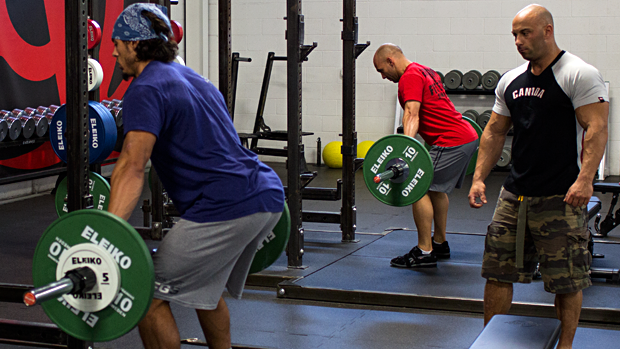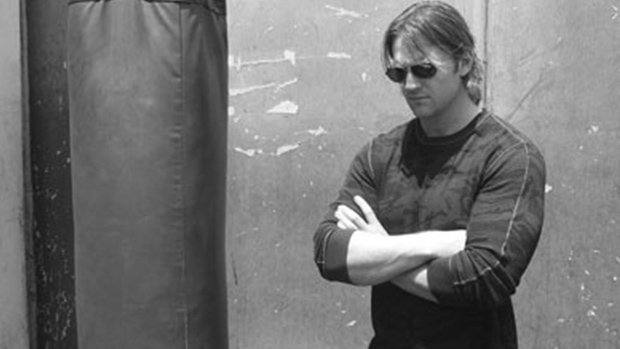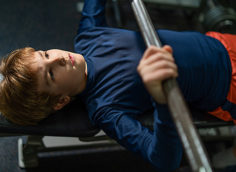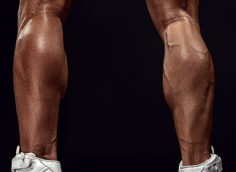CrossFit Training Grows Up
I work with a lot of advanced CrossFit competitors. In fact, they're the athletes I like to train the most. They're the hardest workers and the biggest technique geeks I've seen, contrary to what most people believe.
CrossFit as a sport is evolving, and the training is slowly catching up. As you've guessed, the best competitors at the CrossFit Games don't just do the daily WOD handed down by CrossFit HQ.

Nobody wins with their bodyweight skills. While being really bad at bodyweight skills can certainly prevent you from winning, being excellent at them will not win you anything if you're weak in the big lifts.
You used to have a few special CrossFit competitors who had abnormally good clean and jerks or snatches of 190 pounds or more, but now you have tons of girls doing 185 pounds or more on snatches and 235 pounds or more on clean & jerks.
As far as the men, you had people thinking Froning was an alien because he had a 285-pound snatch, but now you're not even in the game if you can't snatch 275 pounds. You even have some CrossFit athletes clean & jerking 400 pounds!
Consider this:
- There is always a form of ladder training that works up to super heavy weights in all the major CrossFit competitions. Most of the time it's a variation of the Olympic lifts.
- The variations of the Olympic lifts are included in more and more competitive WODs and now use much heavier weights than in the past.
- The competition is so close that every second counts. You need technical mastery more than ever, because missing a rep could mean dropping 2-3 places.
As a result, much of training should be spent on the Olympic lifts. For example, I train the athletes I work with 2 or 3 times per week on the Olympic lifts and they also train them on their own to some extent on 1 or 2 more days.
Add to that fact that a lot of high level CrossFit competitors are former elite weightlifting competitors. (Matt Fraser and Lauren Fisher, for example.)
In fact, in a few weeks I'm bringing several of my CrossFit athletes to a weightlifting contest to qualify them for the national championships. Quite a few of them should make it.
In the future, the smartest CrossFit competitors will basically be "Olympic lifters with great work capacity," in that they will train a lot like high level weightlifters with the added metabolic conditioning and skill work. We'll also see more and more athletes competing in both CrossFit and weightlifting competitions.
As far as training the O-lifts is concerned, the following requirements are paramount:
The technique level you now see in elite competitors far surpasses that seen in all other athletes, except elite weightlifters. Do not judge their technique based on what they do in competitive WODs because even Klokov and Ilyin would look like they had bad technique if they did a competitive WOD.
It's a given that there will be some technical breakdown during a competitive WOD. Fine, but if you already have bad form to start with, it will become horrible during a WOD! Conversely, if you have excellent technique you'll maintain decent form even when pressed for time.
The more stable or repetitive your technique is, the less likely you are to miss reps that could cost you time in a competitive WOD. And the only way to get that solid, repetitive technique is to improve strength-skill. To do that you need to train the lifts with proper form often.
CrossFit is "pulling dominant" when it comes to the lower body. Deadlifting, kettlebell swings, and the like build the hip hinge mechanism and as a result it becomes the premier lifting strategy of CrossFit competitors.
As a result they often bump the bar away from their body with their hips and have no precision as far as where the barbell lands. They need to learn how to pull close to their body from the floor using their legs, not their back.
Then they need to learn how to open up the torso while sweeping the bar on the thighs so they get in a position to explode upwards with the legs instead of forward with the hips.
The hip hinge is mostly to bring the bar in the right position to use the legs properly, but the quads should do the actual upward explosion.
This isn't done by going to a max or a PR everyday, which is quite common in CrossFit circles. In competitive weightlifting it's well known that you develop quality lifting (technique and strength) by doing a lot of volume with 75-85% of your 1RM.
Yes it's important to use heavier weights than that, but most of your work should be spent in the 75-85% range for sets of 3 reps.
You're probably thinking, "Yeah, but the Bulgarians go to a max every day!" or "Pat Mendes on YouTube always goes to a daily max."
Well, you aren't Bulgarian and you aren't an advanced lifter. Once you have world-class technique and technical stability, regardless of the weight, you can begin to talk about "Bulgarian." Until then focus on what works to build both technique and strength.
Even in weightlifting this is a hot debate. You have the "Bulgarian-ish" school of thought that has a lifter attempt a max several times a week, sometimes every day. They allow the lifter up to 6 misses at a given weight. If they don't get it after 6 tries they stop.
Then you have the Russians and Chinese who seem to never miss a rep in training, or very rarely.
I side with the second group. I used to belong to the first school of thought – going up super heavy all the time, allowing myself up to 6 misses – and I sucked as a lifter! I was strong (600-pound squat, 465-pound front squat), but had very inconsistent technique.
Had I known then what I know now I would have achieved a lot more. But then again, being a bad lifter helped me become a good coach.
So, you should rarely miss a lift in training, especially in the development phase. Missing is probably going to happen, but you still need to keep misses at 10% or under.
The less often you miss, the more confidence you'll have and the more stable your technique will be under stressful conditions.

CrossFitters base everything on their personal record. This is a mistake for athletes who do not yet have stable technique.
When planning your weights you should start from a weight you can hit any week without any special preparation, a weight that you would hit at least 7 or 8 times out of 10.
When it comes to the Olympic lifts as well as the basic strength movements, it seems to be all about the PR.
It's not surprising, though. It goes along with the obsession with doing the best time, doing the most rounds, going the fastest. Chasing PR's is to lifting what doing all-out WODs is to metabolic conditioning.
You prepare for a PR. You train for it. You develop optimal technique to do the PR efficiently. PR chasing is like trying to learn by only doing tests.
A PR should come by itself. With proper training there will come a point where your technique is so efficient and your muscles so much stronger that PRs will come naturally.
Attempting a true PR when your technique isn't stable is simply dumb. If you can't maintain the same technique in these attempts as with your regular lifts, you're not ready.

How strong do you need to be? The answer to that question will always be "stronger than you are now." I see no ceiling to how strong you should attempt to get when competing in CrossFit.
Obviously you won't get as strong as the top powerlifters who specialize in strength, but you should attempt to get as strong as you can. To be a strong CrossFit competitor you should handle 70% of the "raw" powerlifting records.
For example, let's take the average CrossFit competitor who's likely between 195 and 205 pounds. The raw powerlifting records for the 198-pound weight class are:
- 750-pound squat by Jesse Norris
- 565-pound bench press by Larry Danaher
- 870-pound deadlift by Andrey Belyaev
As such, elite strength for a CrossFit competitor would require something like a 525-pound squat, a 395-pound bench press, and a 610-pound deadlift.
From there we can estimate some other lifts, too:
- Front squat: 385 pound
- Military press: 235 pounds
- Push press: 305 pounds
Do all high level CrossFit competitors possess elite strength levels? No. And not all of them have balanced strength either, but these are good goals to shoot for. If you reach them all, strength will never be a limiting factor in anything you do in training or competition.
Still, we need to ask the obvious question: Why does a CrossFit competitor need to be strong?
- There are more and more heavy lifts involved in competitive WODs.
- The stronger you are, the proportionally lighter the WOD weights become.
Doing 20 deadlifts with 275 pounds is much easier if your top deadlift is 550 pounds than if it's 325 pounds.
- The stronger you are, the higher your potential on the Olympic lifts.
Being strong is no guarantee of having good results on the Olympic lifts. I know plenty of guys who can deadlift close to 600 pounds, but who can't snatch over 225 pounds.
However, having a great strength reserve will allow you to reach higher results once you master optimal Olympic lifting technique.
Another factor is that you do not develop elite strength levels by only doing WODs. And even if you practice the Olympic lifts often, they will not develop elite strength by themselves. To get strong you need to do strength work!
Karim El Hlimi and Roch Proteau – who competed at the CrossFit Games – are two great CrossFit coaches I work with who plan strength work 3 or 4 times a week. They do not do a lot of volume because CrossFit athletes already spend a lot of training "money" on other things like skill training and metcons.
They normally do 1 or 2 strength exercises in a session. When they do two, it's in alternating fashion. And they normally do 4-6 sets.
My athletes will do 1 or 2 strength lifts after their Olympic lift training. We normally focus on the front squat and clean or snatch deadlift, but if someone is very unbalanced in their strength levels, they should probably spend more energy bringing their weakest lifts up.

The root of most of the problems associated with CrossFit training lies with the scoreboard or scoreboard mentality. Sadly it's also one of the things that made it big.
A workout is meant to build your body, skills, and physical capacities, not test yourself. Can you improve by "testing" yourself in the gym? Sure! But if you do it all the time you will increase the risk of injuries, deplete your capacity to recover, and hit a progression wall very fast.
Training should be challenging, but it needs to stay within your recovery capacities, otherwise you'll start to have issues and positive adaptations will become negative adaptations (stagnation and even regression).
Roch Proteau, who has competed in the Games both as an individual competitor and a team athlete, and who trains a ton of high level competitors, told me that his athletes normally train at about an 8/10 and sometimes even 7/10 on the perceived effort scale.
They occasionally go to 9/10, which is close to your limit but not to a point where your technique starts to suffer.
His athletes are prescribed a workload that they must complete. When it's a WOD they must complete it rapidly but there's no time cap and the emphasis is not on getting the best time possible, but on doing the movements as well as possible while taxing the proper energy system.
There is no scoreboard at his gym where athletes write down their WOD score.

The scoreboard is a big reason why CrossFit became popular: People like to compare themselves to others as well as impress them.
Some get an extra boost in motivation knowing that others will see what they did. They don't want to look bad so they go extra hard to turn in a good time. The scoreboard also makes people feel like they are competitive athletes, which is something that attracts a lot of people.
But what started out as a good thing in theory actually led to more problems than benefits.
When you have a scoreboard where everybody can see what you did and how you compare to others, you will have the natural tendency to go as fast as you can, often at the expense of effective and safe technique.
When the main goal is to go fast, people tend to take "technical shortcuts." Even at the CrossFit Games, you don't always see perfect technique, but that's fine – it's a competition.
Criticizing a Games athlete for his power clean form during a competitive WOD is like criticizing an NFL running back for not showing perfect sprinting mechanics during a run.
The first step is to get rid of that scoreboard. Then change the mentality. When you are in the gym you are training, you are not competing. No athlete in the world routinely trains with the same intensity level that he competes at.
You can have a brief period of all-out training. Normally, 2 or 3 weeks in a 12-week cycle should be all-out weeks (and not always back-to-back), but 9-10 of those weeks should be used to improve your physical capacities and your skills. Focus on quality.
By going all-out all the time you not only risk injuries and learn bad motor habits, you also increase the possibility of exceeding your capacity to recover. And when that happens, performance, motivation, and wellbeing will be affected.
By the same token, I believe that AMRAPs (As Many Reps/Rounds As Possible) in a given time frame should be avoided during regular training and should only be used when testing yourself.
AMRAPs act like the scoreboard. It makes you focus on the "score" instead of focusing on the proper training effect and the quality of the execution.

I spend a good amount of time in CrossFit gyms and one thing that never ceases to amaze me is the amount of supplement bottles they carry in their gym bag. This is especially true of the competitive athletes who are desperately looking for an edge.
Sadly, most of them are using stuff that's ineffective (especially for their specific goal) or suboptimal, if not completely counterproductive. CrossFit athletes seem to be in love with their "pre-WOD" formula. They use high stimulant formulas, hoping that it will give them an edge during WODs.
I'm not against the occasional use of stimulants. However, I prefer to use supplements that affect the nervous system in a more precise way – increasing focus, confidence, coordination, etc.
Pure stimulants, like energy drinks, should be kept as an occasional tool to use when you're not feeling energetic. They should not be part of your everyday routine.
Instead of focusing on getting "jacked up," CrossFitters need to focus on actual workout nutrition. My athletes, at the very least, use Plazma™, Mag-10®, and Brain Candy® and they get great results.
Other very high-level competitors also use Biotest supplements, despite being sponsored by other companies. I won't mention them to avoid getting them in trouble.
Optimizing peri-workout nutrition – meaning before, during and after training – is the most important thing you can do to maximize your gains.
Having the proper nutrients in you when you're training will maximize nutrient transport to the muscles that are actually being stimulated. This will not only increase your gains, it will also make your body recover at a much faster rate, allowing you to train harder, more often.
A big problem with CrossFit training is that people tend to push the boundaries of what the body can recover from. This is especially true for competitors who need to push many different physical capacities and skills to the highest level.
When you use Plazma™ before and during your workout and Mag-10® post-workout you'll recover faster and be able to handle a greater workload without suffering a decrease in performance.
If you can train more and train harder without exceeding your capacity to recover, you will progress at a faster rate. Period.
Overall, supplements are there to address a specific issue. Don't be emotionally seduced, be intellectually convinced!

In short, the keys to becoming a good CrossFit athlete are:
- Be good at the Olympic lifts. This is done by training like a weightlifter, not doing the lifts in WODs.
- Be strong.
- Ditch the scoreboard. Training is not testing.
- Supplement wisely. Concentrate on workout nutrition.
- Have solid bodyweight skills.
- Have a good foundation of aerobic capacity.
- Have a very high level of anaerobic capacity and power.
- Develop physical capacities without involving a high skill component. You want to gain strength? Do heavy work on the big basic lifts. You want to improve your anaerobic capacities? Go hard on the Prowler, farmer's walk, rowing ergometer, or Airdyne bike.
- Do more general training the further away you are from your competition. This means that you focus on developing the basic capacities (strength, aerobic capacity, anaerobic capacity) and skills (weightlifting and bodyweight exercises) by themselves, trying to get them to the highest possible level.
As you get closer to the competition you start to integrate more specific work. This means "complexing" different elements together.
At first this can mean doing "supersets/complexes" of a strength movement with one of skill, or doing a complex of a strength or skill exercise along with a metabolic conditioning drill.
In the future the best athletes will be those who train like athletes – planning their training properly, pushing it hard when it's the right time, avoiding the urge to exceed their capacity to recover (fatigue masks fitness), and who use supplements smartly.




